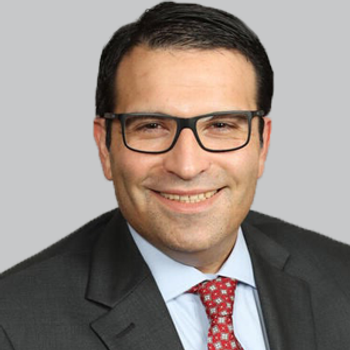
Stem Cell Therapy for Spinal Cord Injury on Pace to Soon Enter Human Phase Testing
In an AAN plenary talk, Mark H. Tuszynski, MD, PhD, detailed the work he and colleagues have done to push stem cell therapy from the lab to the clinic to improve care for spinal cord injury.
Stem cell therapy has begun to revolutionize medicine over the last decade, and in recent years, attempts to improve and potentially repair spinal cord injury with a stem cell approach have started to take root. If all goes well, a stem cell approach to spinal cord injury could enter human clinical trials in the next 2 to 3 years, according to Mark H. Tuszynski, MD, PhD, FAAN.
The
“We've learned a great deal in the last 50 years about why the central nervous system (CNS) doesn't regenerate and why the spinal cord doesn't regenerate after injury,” Tuszynski explained. “One reason amongst these is a lack of permissive substrates for axon growth and a lesion cavity. The cystic lesion cavity is filled with fluid, and axons cannot attach to a fluid-filled environment that lacks cells or a molecular substrate.”
The second reason, he added, is the lack of sufficient growth factor support to injured axons in the CNS, unlike in the periphery. Another is the presence of inhibitory proteins which form in the extracellular matrix after spinal cord injury that actively block regeneration, and the ongoing inflammation impairs growth.
Although, stem cell grafts can potentially combat almost all of these challenges. Tuszynski highlighted that they can offer a permissive substrate for host axons to grow while providing trophic support through the secretion of growth factors. Additionally, the axons that grow below the lesion are not inhibited by white matter, unlike adult axons. “Indeed, they're stimulated to grow on white matter because of the presence of any GR1 receptors—something we reported in Science Translational Medicine last year,” he said.
With regard to inflammation, stem cell grafts can attenuate glial “scarring” by allowing the reformation of a neural milieu and eliminating the reactive astrocyte response. Ultimately, Tuszynski noted, when provided with a graft, the neurons can spontaneously regenerate.
RNA sequencing of adult cortical spinal neurons in Tuszynski and colleagues’ injury models showed further information about the ongoing processes from a genetic standpoint. He noted that in a hierarchical clustering of the top 1000 differentially expressed genes, the subsequent expression following the initial injury response in the absence of a graft fades within 3 weeks, and neurons return to the basal transcriptional state. But in the presence of a stem cell graft, the transcriptomic response to injury is maintained—and thus cortical spinal axons can regenerate.
READ MORE:
“Regeneration is not so much a feature in that you have different genes being expressed when the axon regenerates. It's a persistence of a natural state that the cell adopts after injury spontaneously,” he explained. “So what is that natural transcriptomic state? It is literally a reversion to an embryonic state of transcription in the cortical spinal motor neuron.”
“Astonishingly, injured neurons of the adult brain revert to an embryonic state after injury, and when provided with a permissive environment, they can repair. We aim to move this along [to humans] if all the data support this and it's safe over a time period of 2 to 3 years,” he added.
Tuszynski explained that prior to stem cell research, 2 decades of work in rats culminated in the regeneration of 100 axons within a preinjury population of 1 million axons over 1 mm. Now, however, implanting neural stem cells allows for the regeneration of far greater numbers—in rhesus monkeys, up to 300,000 axons over a 50 mm distance. “The overall amount of growth emerging from a stem cell graft is on the order of tens of thousands of times greater in magnitude than the amount of regeneration exhibited by an injured adult axon,” he said.
Tuszynski then walked the audience through the experience of stem cell grafting in rats, using neural stem cells of mouse, rat, or human origin, existing in the time between the neural stem cell phase—when the cells remain multipotent and self-renewing while committed to a neural fate—and the transition to the intermediate neural progenitor phase—when the cells become limited in self-renewal. This process would then allow for the generation of both neurons and glia. The graft would take place 14-28 days post spinal cord injury in a lesion cavity in the fibrin/thrombin matrix to fill the lesion site, with growth hormones such as BDNF, FGF2, VEGF, and MDL28170 included to promote cell survival.
They viewed the effects for 2 to 24 months, and Tuszynski explained that “when we do this, we see robust axonal outgrowth from the neural stem cells implanted in the lesion site,” and that “indeed, host axons extensively regenerate into these grafts, all of these growing axons form synapses with their targets, and they restore, partially, function.”
He explained that similar results were shown after C7 hemisections in rhesus monkeys, during which time they had impairment in the right hand, but could still walk and had autonomic function. When tested on motor tasks like retrieving raisins from Brinkman's boards of varying difficulty and observing object manipulation using the hand, following grafting, some monkeys showed an ability to extend the fingers.
“Overall, their ability to extend the fingers and manipulate objects improves by about 50%,” Tuszynski said. “It is still not complete recovery, but the magnitude of improvement is consistent with the non-primate studies, indicating some replicability of this whole type of effect. But their recovery could be better. Nonetheless, with this degree of recovery, if an injured human could recover some finger use, that might enable them to type on a keyboard to control their wheelchair if they hadn't been able to previously.”
Tuszynski concluded by noting that currently, in his group’s ongoing preclinical studies and in preparation for moving the work to human clinical trials, they are optimizing grafting methods for both cell survival and lesion fill after contused spinal cord injury. The goal, he noted, is graft survival in almost all of the animals.
“We are examining long-term safety, tolerability, and efficacy of this approach in non-human primates, and we are, in parallel, developing a good manufacturing practice for a quality human spinal cord neural stem cell line that would move into the clinic and meet the requirements of the FDA for human use,” he said.
For more coverage of AAN 2021,
REFERENCE
Tuszynski MH. Stem Cell Therapy for Spinal Cord Injury: Transition to the Clinic. Presented at 2021 American Academy of Neurology Annual Meeting. Frontiers in Neuroscience plenary session.
Newsletter
Keep your finger on the pulse of neurology—subscribe to NeurologyLive for expert interviews, new data, and breakthrough treatment updates.


































